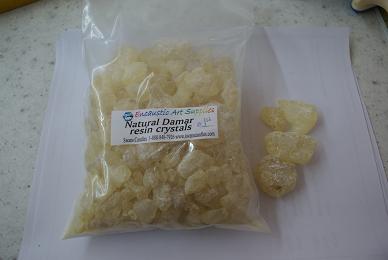More InfoDammar gum is obtained from the Dipterocarpaceae family of trees in India and East Asia, principally those of the genera Shorea, Balanocarpus or Hopea. Most is produced by tapping trees; however, some is collected in fossilized form from the ground. The gum varies in colour from clear to pale yellow, while the fossilized form is grey-brown. Dammar gum is a triterpenoid resin, containing a large number of triterpenes and their oxidation products. Many of them are low molecular weight compounds (dammarane, dammarenolic acid, oleanane, oleanonic acid, etc.), but dammar also contains a polymeric fraction, composed of polycadinene.[1] It is used in foods, as either a clouding or a glazing agent, in the making of incense, varnishing and in other processes. Dammar was first introduced as a picture varnish in 1826, and is commonly referred to as dammar varnish. The varnish, made from dammar gum and turpentine[2] is commonly used in oil painting, both during the painting process and after the painting is finished. (From Wikipedia) Materials/Ingredientspure damar resin crystals ReviewsAverage rating: 1 reviews | Read all reviews Featured positive reviews:Swans' damar resin is the best i have found anywhere. it is very clean and consistent in size. I don't use any other unless they run out!

|
||||
CategoriesBack HomeMore InfoYour AccountWish ListGift CertificateYour Shopping Cart |
Swans Candles is a private label manufacturer, we can make your recipe for you, Need a custom formula, Swans can make it for you. Check out our new Encaustic Paint page, link on left sidebar. |







